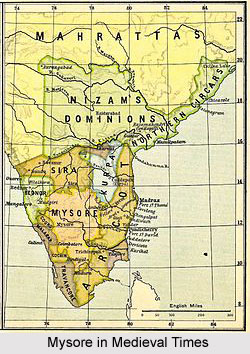 Krishna Raja Wodeyar III was one of the most efficient rulers of Mysore, famous for the patronage of arts and music in Mysore. Krishna Raja Wodeyar III ruled Mysore from 30 June 1799 to 27 March 1868.
Krishna Raja Wodeyar III was one of the most efficient rulers of Mysore, famous for the patronage of arts and music in Mysore. Krishna Raja Wodeyar III ruled Mysore from 30 June 1799 to 27 March 1868.
Early Life of Krishna Raja Wodeyar III
Mummadi Krishnaraja Wadiyar or Krishna Raja Wodeyar III was born at Srirangapatna. He was the son of Khasa Chamaraja Wadiyar IX and his first wife, Maharani Kempa Nanja Ammani Avaru. Chamaraja Wadiyar IX was the adopted son of Maharani Lakshmi Ammani Devi, the widow of Krishnaraja Wadiyar II. Maharani Lakshmi Ammani Devi played a major role in the development of her adopted grandson, Mummadi Krishnaraja Wodeyar who was better known as Krishna Raja Wodeyar III. He played a most important role in his ascendancy to the Mysore throne.
Accession of Krishna Raja Wodeyar III
The Wadiyars or the Wodeyars had lost the power of Mysore to Hyder Ali in the year 1766. Maharani Lakshmi Ammani Devi was waiting for a chance to unseat Hyder Ali and later his son Tipu Sultan, and had sent numerous feelers to the British East India Company to unseat them and hand over the kingdom to the Wadiyars. She also informed the British East Indian Company about the treaty between Tipu Sultan and the French East India Company. When Tipu Sultan died at the hands of the British in the Battle of Seringapatna, in the year 1799, she discussed about the handover of the Mysore throne, which finally led to the Krishnaraja Wodeyar, as the ruler of Mysore on 30 June 1799. At that time, he was only five years old. The ceremony of coronation took place in a special pavilion constructed near the Lakshmiramana Swamy temple in Mysore. Dewan Purnaiah was selected as the Dewan of Mysore with an indication that he should be loyal to the king till the king himself attains an age of discretion.
Krishna Raja Wodeyar III attained the throne at the age of 16 in early 1810. Hence Krishna Raja Wodeyar III attained the age of discretion. After discussing with the British Resident, A. H. Cole, the reins of the state of Mysore were transferred from Dewan Purnaiah to the king of Mysore.
Rule of Krishna Raja Wodeyar III
Krishna Raja Wodeyar III ruled Mysore state when the political life of South India is tumultuous. The years that followed witnessed cordial relations between Mysore and the British East India Company until things began to sour in the 1820s. Even though the Governor of Madras, Thomas Munro determined after a personal investigation in 1825 that there was no substance to the allegations of financial impropriety made by A. H. Cole, the incumbent Resident of Mysore, the civil insurrection which broke out towards the end of the decade changed things considerably. In the year 1831, close to the heels of the insurrection and citing mal-administration, the British East India Company and later the British Government took direct control of the princely state of Mysore. For the next fifty years, the princely Mysore passed under the rule of successive British Commissioners; Sir Mark Cubbon, renowned for his statesmanship.
Contribution of Krishna Raja Wodeyar III
Krishna Raja Wodeyar III was responsible for the cultural growth of the Mysore. Krishna Raja Wodeyar III was himself a writer, having written the books on Kannada Language like Sritattvanidhi and Sougandhikaparinaya. Krishna Raja Wodeyar III also has a number of writers in his court who together contributed to the development of modern prose in Kannada language. The Champu style of prose was followed till then. Other important writings of Krishna Raja Wodeyar III that emerged during the rule of Krishna Raja Wodeyar III include Mudramanjusha by Kempu Narayana, Kalavati Parinaya by Yadava and Vachana Kadamabari. Krishna Raja Wodeyar III was well versed in many languages and could play "Veena". He was a great patron of music also. He was an expert player of board games and is credited to have revived the Ganjifa art game. Krishna Raja Wodeyar III was also a collector and an inventor of board games. During his kingship, there was a gradual progression of art, architecture and culture of Mysore.



















